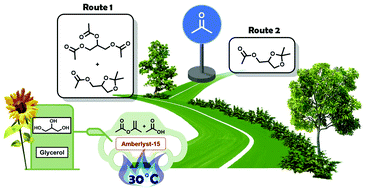A transesterification–acetalization catalytic tandem process for the functionalization of glycerol: the pivotal role of isopropenyl acetate†
Abstract
At 30 °C, in the presence of Amberlyst-15 as a catalyst, a tandem sequence was implemented by which a pool of innocuous reactants (isopropenyl acetate, acetic acid and acetone) allowed upgrading of glycerol through selective acetylation and acetalization processes. The study provided evidence for the occurrence of multiple concomitant reactions. Isopropenyl acetate acted as a transesterification agent to provide glyceryl esters, and it was concurrently subjected to an acidolysis reaction promoted by AcOH. Both these transformations co-generated acetone which converted glycerol into the corresponding acetals, while acidolysis sourced also acetic anhydride that acted as an acetylation reactant. However, tuning of conditions, mostly by changing the reactant molar ratio and optimizing the reaction time, was successful to steer the set of all reactions towards the synthesis of either a 1 : 1 mixture of acetal acetates (97% of which was solketal acetate) and triacetin, or acetal acetates in up to 91% yield, at complete conversion of glycerol. To the best of our knowledge, a one-pot protocol with such a degree of control on the functionalization of glycerol via transesterification and acetalization reactions has not been previously reported. The procedure was also easily reproduced on a gram scale, thereby proving its efficiency for preparative purposes. Finally, the design of experiments with isotopically labelled reagents, particularly d4-acetic acid and d6-acetone, helped to estimate the contribution of different reaction partners (iPAc/AcOH/acetone) to the formation of final products.



 Please wait while we load your content...
Please wait while we load your content...